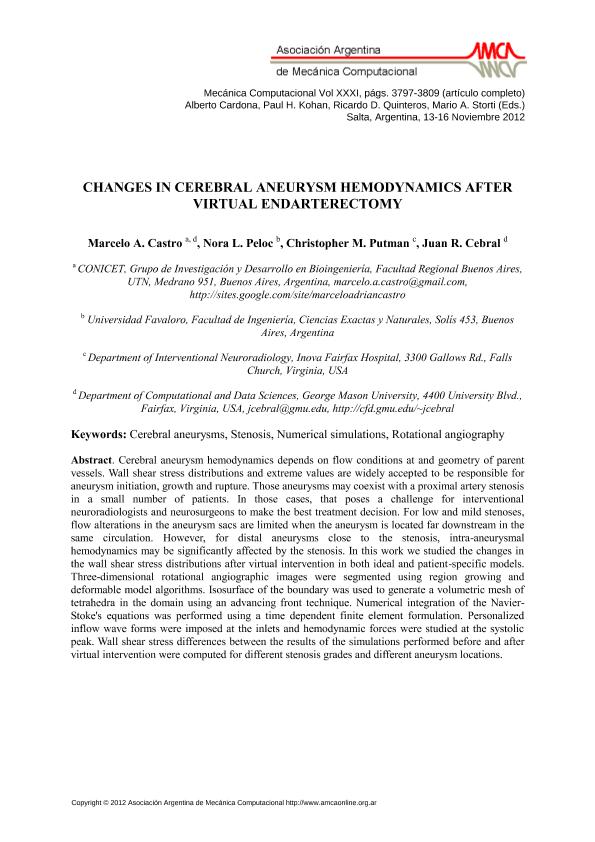Mostrar el registro sencillo del ítem
dc.contributor.author
Castro, Marcelo Adrian

dc.contributor.author
Peloc, Nora Luz

dc.contributor.author
Putman, Christopher M.
dc.contributor.author
Cebral, Juan Raúl
dc.date.available
2023-05-29T17:51:01Z
dc.date.issued
2012-11
dc.identifier.citation
Castro, Marcelo Adrian; Peloc, Nora Luz; Putman, Christopher M.; Cebral, Juan Raúl; Changes in cerebral aneurysm hemodynamics after virtual endarterectomy; Asociación Argentina de Mecánica Computacional; Mecánica Computacional; 31; 11-2012; 3797-3809
dc.identifier.issn
1666-6070
dc.identifier.uri
http://hdl.handle.net/11336/198853
dc.description.abstract
Cerebral aneurysm hemodynamics depends on flow conditions at and geometry of parents vessels. Wall shear stress distributions and extreme values are widely accepted to be responsible for aneurysm initiation, growth and rupture. Those aneurysms may coexist with a proximal artery stenosis in a small number of patients. In those cases, that poses a challenge for interventional neuroradiologists and neurosurgeons to make the best treatment decision. For low and mild stenoses, flow alterations in the aneurysm sacs are limited when the aneurysms is located far downstream in the same circulation. However, for distal aneurysms close to the stenosis, intra-aneurysmal hemodynamics may be significantly affected by the stenosis. In this work we studied the changes in the wall shear stress distributions after virtual intervention in both ideal and patient-specific models. Three-dimensional rotational angiographic images were segmented using region growing and deformable model algorithms. Isosurface of the boundary was used to generate a volumetric mesh of tetrahedra in the domain using an advancing front technique. Numerical integration of the Navier-Stoke's equations was performed using a time dependent finite element formulation. Personalized inflow wave forms were imposed at the inlets and hemodynamic forces were studied at the systolic peak. Wall shear stress difference between and after virtual intervention were computed for different stenosis grades and different aneurysm locations.
dc.format
application/pdf
dc.language.iso
eng
dc.publisher
Asociación Argentina de Mecánica Computacional
dc.rights
info:eu-repo/semantics/openAccess
dc.rights.uri
https://creativecommons.org/licenses/by-nc-sa/2.5/ar/
dc.subject
Cerebral aneurysms
dc.subject
Stenosis
dc.subject
Numerical Simulations
dc.subject
Rotational angiography
dc.subject.classification
Otras Ingenierías y Tecnologías

dc.subject.classification
Otras Ingenierías y Tecnologías

dc.subject.classification
INGENIERÍAS Y TECNOLOGÍAS

dc.title
Changes in cerebral aneurysm hemodynamics after virtual endarterectomy
dc.type
info:eu-repo/semantics/article
dc.type
info:ar-repo/semantics/artículo
dc.type
info:eu-repo/semantics/publishedVersion
dc.date.updated
2023-05-18T14:27:15Z
dc.journal.volume
31
dc.journal.pagination
3797-3809
dc.journal.pais
Argentina

dc.description.fil
Fil: Castro, Marcelo Adrian. Universidad Tecnológica Nacional. Facultad Regional Buenos Aires. Secretaria de Ciencia y Técnica; Argentina. George Mason University; Estados Unidos
dc.description.fil
Fil: Peloc, Nora Luz. Universidad Favaloro. Facultad de Ingeniería y Ciencias Exactas y Naturales; Argentina
dc.description.fil
Fil: Putman, Christopher M.. Innova Fairfax Hospital; Estados Unidos
dc.description.fil
Fil: Cebral, Juan Raúl. George Mason University; Estados Unidos
dc.journal.title
Mecánica Computacional
Archivos asociados
